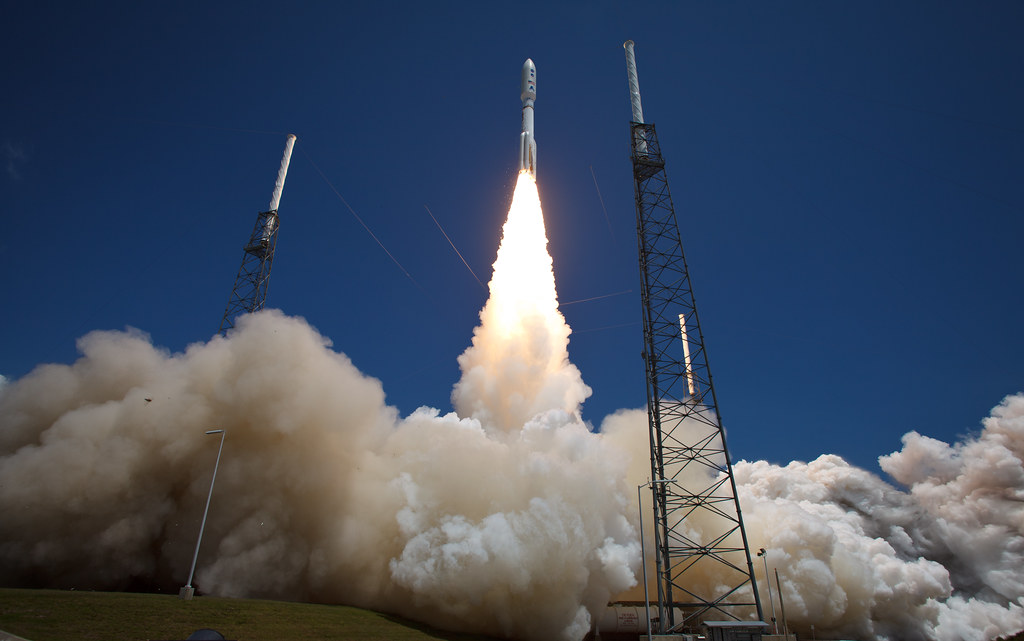The Atlas V launch vehicle with the world's largest Mars rover, Perseverance, was launched on July 30 from the Cape Canaveral launch site in Florida. It should deliver the rover to Mars on February 18, 2021. The launch of the new space mission was broadcast on the NASA YouTube channel.
The launch took place in normal mode. The booster stage entered an intermediate orbit. The total cost of creating the device and launching is estimated at $ 2.4 billion, writes Reuters. The agency clarifies that the state of Florida, where the launch took place, is now one of the "hottest spots in the US for the coronavirus pandemic."
The rover weighs 1,025 kg, is 3 m long and 2.7 m wide. It has a soil collection drill in which the rover will look for signs of microbial life in the past of Mars. In April, Nature wrote that the samples taken by the rover in 2028 will be taken by another device, which is planned to be sent in 2026.
In addition, a robotic arm and video cameras are installed on the rover. As an experiment, Perseverance also carries a small helicopter called Ingenuity, which, if successful, will become "the first flying vehicle in a controlled flight to another planet," Bloomberg writes with reference to the US space agency.
The rover's mission will be not only to collect soil and study the climate, but also to help prepare for new missions with the participation of people. Two days before the launch, NASA announced that Perseverance will deliver to Mars samples of various materials that experts are going to use to create spacesuits for landing people on the surface of the Moon and Mars. This will test how the samples will be affected by the Martian environment.
It is possible that the most dramatic goal of the mission will be an attempt by the rover to demonstrate a technology that converts carbon dioxide in the atmosphere of Mars into oxygen, Bloomberg points out. "In the future, oxygen obtained in this way could be used by astronauts as rocket fuel and for breathing," notes NASA. This capability will be critical when planning the landing of humans and bases on Mars, the agency emphasizes.
The new mission became the third launched to Mars in the last ten days. On July 20, the Al Amal (Hope) spacecraft of the United Arab Emirates departed for the Red Planet on a Japanese H-IIA launch vehicle. It will study the climate and the lower atmosphere. Then on July 23, a heavy launch vehicle Changzheng-5 (CZ-5) was launched to Mars with the first Chinese mission to explore Mars, Tianwen-1.
source: reuters.com
The launch took place in normal mode. The booster stage entered an intermediate orbit. The total cost of creating the device and launching is estimated at $ 2.4 billion, writes Reuters. The agency clarifies that the state of Florida, where the launch took place, is now one of the "hottest spots in the US for the coronavirus pandemic."
The rover weighs 1,025 kg, is 3 m long and 2.7 m wide. It has a soil collection drill in which the rover will look for signs of microbial life in the past of Mars. In April, Nature wrote that the samples taken by the rover in 2028 will be taken by another device, which is planned to be sent in 2026.
In addition, a robotic arm and video cameras are installed on the rover. As an experiment, Perseverance also carries a small helicopter called Ingenuity, which, if successful, will become "the first flying vehicle in a controlled flight to another planet," Bloomberg writes with reference to the US space agency.
The rover's mission will be not only to collect soil and study the climate, but also to help prepare for new missions with the participation of people. Two days before the launch, NASA announced that Perseverance will deliver to Mars samples of various materials that experts are going to use to create spacesuits for landing people on the surface of the Moon and Mars. This will test how the samples will be affected by the Martian environment.
It is possible that the most dramatic goal of the mission will be an attempt by the rover to demonstrate a technology that converts carbon dioxide in the atmosphere of Mars into oxygen, Bloomberg points out. "In the future, oxygen obtained in this way could be used by astronauts as rocket fuel and for breathing," notes NASA. This capability will be critical when planning the landing of humans and bases on Mars, the agency emphasizes.
The new mission became the third launched to Mars in the last ten days. On July 20, the Al Amal (Hope) spacecraft of the United Arab Emirates departed for the Red Planet on a Japanese H-IIA launch vehicle. It will study the climate and the lower atmosphere. Then on July 23, a heavy launch vehicle Changzheng-5 (CZ-5) was launched to Mars with the first Chinese mission to explore Mars, Tianwen-1.
source: reuters.com





